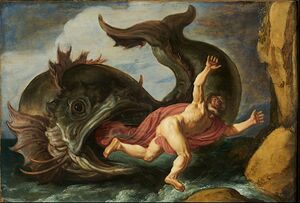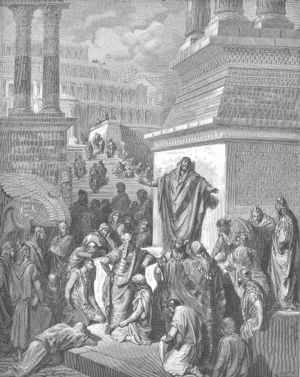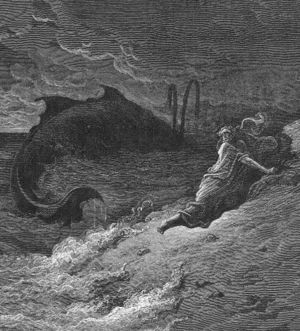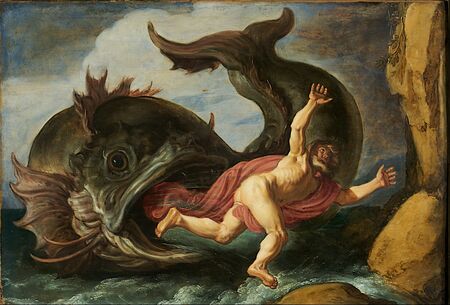سفر يونان

 | |||||
| تناخ (اليهودية) | |||||
|---|---|---|---|---|---|
|
|
|||||
| العهد القديم (المسيحية) | |||||
|
|
|||||
| بوابة الكتاب المقدس | |||||
سفر يونان Book of Jonah، هو واحد من الأنبياء الصغار في الكتاب العبري. is one of the twelve minor prophets of the Nevi'im ("Prophets") in the Hebrew Bible, and as a book in its own right in the Christian Old Testament. The book tells of a Hebrew prophet named Jonah, son of Amittai, who is sent by God to prophesy the destruction of Nineveh, but tries to escape this divine mission.
The story has a long interpretive history and has become well known through popular children's stories. In Judaism, it is the Haftarah portion read during the afternoon of Yom Kippur to instill reflection on God's willingness to forgive those who repent,[1] and it remains a popular story among Christians. The story is also retold in the Quran.
. . . . . . . . . . . . . . . . . . . . . . . . . . . . . . . . . . . . . . . . . . . . . . . . . . . . . . . . . . . . . . . . . . . . . . . . . . . . . . . . . . . . . . . . . . . . . . . . . . . . . . . . . . . . . . . . . . . . . . . . . . . . . . . . . . . . . . . . . . . . . . . . . . . . . . . . . . . . . . . . . . . . . . . .
الاسم


اسم الكتاب في المخطوطات الماسورتية هو سفر يونان وفي الترجمة اللاتينية هو نبؤة يونان وفي الترجمة السريانية هو نبؤة النبي يونان.
التأليف والتاريخ
لا يعرف الكاتب وإن كانت النظرة التقليدية تذكر النبي يونان كمؤلف. وعاش النبي حسب ويستون في القرن التاسع قبل الميلاد. وتم تدوين الكتاب بعد دمار نينوى عام 612 قبل الميلاد حسب المختصين وربما في القرن الرابع قبل الميلاد.
The prophet Jonah is mentioned in 2 Kings 14:25, which places Jonah's life during the reign of Jeroboam II (786–746 BC), but the book of Jonah itself does not name a king or give any other details that would give the story a firm date. The majority of scholars date the book much later, to the post-exilic period sometime between the late 5th to early 4th century BC;[2] perhaps (along with Book of Ruth) as a counter to the emphasis on racial purity in the time of Ezra.[3] An even later date is sometimes proposed, with Katherine Dell arguing for the Hellenistic period (332–167 BC).[4]
Assyriologist Donald Wiseman takes issue with the idea that the story is late or a parable. Among other arguments he mentions that the "Legends of Agade" (see Sargon of Akkad#Origin legends and Rabisu#The Curse of Agade) date to the time of the Old Babylonian Empire, though later versions "usually taken as a late composition, propagandistic fairy tale or historical romance can now, on the basis of new discoveries of earlier sources, be shown to be based on a serious and reliable historical record".[5]
المحتوى
أمر الله يونان أن يعظ مدينة نينوى لكن يونان لم يقتنع بأن المدينة يمكن أن تتوب بالإضافة لكونها مدينة غير يهودية وبالتالي، فهرب في سفينة باتجاه معاكس.ولكن الله أهاج البحر وكادت السفينة أن تغرق فحاول الركاب معرفة السبب غضب الألهة (فقد كانوا وثنيين) فاعترف يونان بذنبه وبأنه رفض طاعة إلهه فرمي خارج السفينة وسكنت العاصفة. أما يونان فقد أعد الله له حوت عظيم لكي يبتلعه وبقي في جوف الحوت ((حجرة تنفس الحوت لانة لو كان قي بطنها كان يموت وذلك بسبب عدم وجود هواءوبسبب ماده هضم الطعام)) ثلاثة أيام بلياليها فدعا الله معترفا بذنبه فقذفه الحوت للساحل وذهب للمدينة العاصية ووعظ سكانها فأعلنوا صوما عاما للتوبة ابتداء من الملك وحتى عامة الشعب والأطفال الرضع والبهائم فعفا الله عنهم، وهذا يدل على أن الخلاص ليس حصرا في قوم بني إسرائيل.
خارج العهد القديم
الأناجيل
حسب إنجيلي متى ولوقا يذكر السيد المسيح يونان كما يلي:
- حِينَئِذٍ قَالَ قَوْمٌ مِنَ الْكَتَبَةِ وَالْفَرِّيسِيِّينَ: «يَا مُعَلِّمُ نُرِيدُ أَنْ نَرَى مِنْكَ آيَةً».
فَقَالَ لَهُمْ: «جِيلٌ شِرِّيرٌ وَفَاسِقٌ يَطْلُبُ آيَةً وَلاَ تُعْطَى لَهُ آيَةٌ إِلاَّ آيَةَ يُونَانَ النَّبِيِّ.
لأَنَّهُ كَمَا كَانَ يُونَانُ فِي بَطْنِ الْحُوتِ ثَلاَثَةَ أَيَّامٍ وَثَلاَثَ لَيَالٍ، هَكَذَا يَكُونُ ابْنُ الإِنْسَانِ فِي قَلْبِ الأَرْضِ ثَلاَثَةَ أَيَّامٍ وَثَلاَثَ لَيَالٍ.
رِجَالُ نِينَوَى سَيَقُومُونَ فِي الدِّينِ مَعَ هَذَا الْجِيلِ وَيَدِينُونَهُ لأَنَّهُمْ تَابُوا بِمُنَادَاةِ يُونَانَ وَهُوَذَا أَعْظَمُ مِنْ يُونَانَ هَهُنَا!(متى 12: 39 - 41)
القرآن
يذكر القرآن ذا النون أي صاحب الحوت واسمه العربي يونس:
- (وذا النون إذ ذهب مغاضبا فظن أن لن نقدر عليه فنادى في الظلمات أن لا إله إلا أنت سبحانك إني كنت من الظالمين فاستجبنا له ونجيناه من الغم وكذلك ننجي المؤمنين)
- (وإن يونس لمن المرسلين * إذ أبق إلى الفلك المشحون فساهم فكان من المدحضين * فالتقمه الحوت وهو مليم * فلولا أنه كان من المسبّحين * للبث في بطنه إلى يوم يبعثون * فنبذناه بالعراء وهو سقيم)
- (فاصبر لحكم ربك ولا تكن كصاحب الحوت إذ نادى وهو مكظوم * لولا أن تداركه نعمة من ربه لنُبذ بالعراء وهو مذموم)
- (فلولا كانت قرية آمنت فنفعها إيمانها إلا قوم يونس لما آمنوا كشفنا عنهم عذاب الخزي في الحياة الدنيا ومتعناهم إلى حين)
يونس و"الحوت"

The Hebrew text of Jonah[6] reads dag gadol (بالعبرية: דג גדול, dāḡ gāḏōl), literally meaning "great fish". The Septuagint translated this into Greek as kētos megas (κῆτος μέγας), "huge whale/sea monster"; and in Greek mythology the term was closely associated with sea monsters.[7] Saint Jerome later translated the Greek phrase as piscis grandis in his Latin Vulgate, and as cētus in Matthew.[8] At some point, cētus became synonymous with whale (cf. cetyl alcohol, which is alcohol derived from whales). In his 1534 translation, William Tyndale translated the phrase in Jonah 2:1 as "greate fyshe", and he translated the word kētos (Greek) or cētus (Latin) in Matthew as "whale".[8] Tyndale's translation was later followed by the translators of the King James Version of 1611 and has enjoyed general acceptance in English translations.
In the book of Jonah chapter 1 verse 17, the Hebrew bible refers to the fish as dag gadol, "great fish", in the masculine. However, in chapter 2 verse 1, the word which refers to fish is written as dagah, meaning female fish. The verses therefore read: "And the lord provided a great fish (dag gadol, דָּג גּדוֹל, masculine) for Jonah, and it swallowed him, and Jonah sat in the belly of the fish (still male) for three days and nights; then, from the belly of the (dagah, דָּגָה, female) fish, Jonah began to pray."
The peculiarity of this change of gender led later rabbis to conclude that Jonah was comfortable enough in the roomy male fish to not pray, and because of this God transferred him to a smaller, female fish, in which Jonah was uncomfortable, to which he prayed.[9]
يونس وشجرة اليقطين
The Book of Jonah closes abruptly with an epistolary warning[10] based on the emblematic trope of a fast-growing vine present in Persian narratives, and popularized in fables such as The Gourd and the Palm-tree during the Renaissance, for example by Andrea Alciato.
St. Jerome differed[11] with St. Augustine in his Latin translation of the plant known in Hebrew as קיקיון (qīqayōn), using hedera (from the Greek, meaning "ivy") over the more common Latin cucurbita, "gourd," from which the English word gourd (Old French coorde, couhourde) is derived. The Renaissance humanist artist Albrecht Dürer memorialized Jerome's decision to use an analogical type of Christ's "I am the Vine, you are the branches" in his woodcut Saint Jerome in His Study.
المصادر
- ^ "Jonah's Path and the Message of Yom Kippur". Archived from the original on 2008-11-18. Retrieved 2009-08-18. United Jewish Communities (UJC), "Jonah's Path and the Message of Yom Kippur."
- ^ Mills, Watson E; Bullard, Roger Aubrey (1990). Mercer Dictionary of the Bible. ISBN 9780865543737.
- ^ An Introduction to the Bible, John Drane, Lion publishing, 1990, p.182-183
- ^ Dell, Katherine J (1996). "Reinventing the Wheel: the Shaping of the Book of Jonah". In Barton, John; Reimer, David James (eds.). After the exile: essays in honour of Rex Mason. Mercer University Press. p. 86-89. ISBN 978-0-86554524-3.
- ^ Lecture "Archaeology and the Book of Jonah", delivered in January, 1978, published as Donald Wiseman (1979). "Jonah's Nineveh" (PDF). Tyndale Bulletin. 30: 29–52. Archived from the original on 2012-01-12. Retrieved 2023-09-20.
{{cite journal}}: CS1 maint: bot: original URL status unknown (link) - ^ Jonah 2:1
- ^ See http://www.theoi.com/Ther/Ketea.html for more information regarding Greek mythology and the Ketos
- ^ أ ب Matthew 12:40
- ^ Bruckner 2004, p. 78.
- ^ "CATHOLIC ENCYCLOPEDIA: Jonah". www.newadvent.org.
- ^ citing Peter W. Parshall, "Albrecht Dürer's Saint Jerome in his Study: A Philological Reference," from The Art Bulletin 53 (September 1971), pp. 303–5 at http://www.oberlin.edu/amam/DurerSt.Jerome.htm
. . . . . . . . . . . . . . . . . . . . . . . . . . . . . . . . . . . . . . . . . . . . . . . . . . . . . . . . . . . . . . . . . . . . . . . . . . . . . . . . . . . . . . . . . . . . . . . . . . . . . . . . . . . . . . . . . . . . . . . . . . . . . . . . . . . . . . . . . . . . . . . . . . . . . . . . . . . . . . . . . . . . . . . .
قراءات إضافية
- De La Torre, Miguel A., "Liberating Jonah: Toward a Biblical Ethics of Reconciliation," Orbis Books, 2007.
وصلات خارجية
- An English translation of the most important medieval Christian commentary on Jonah, "The Ordinary Gloss on Jonah," PMLA 128.2 (2013): 424–38.
سفر يونان
| ||
| سبقه عوبديا |
الكتاب العبري | تبعه ميخا |
| العهد القديم المسيحي | ||
- CS1 maint: bot: original URL status unknown
- Short description matches Wikidata
- Articles containing عبرية-language text
- Articles containing Ancient Greek (to 1453)-language text
- Articles containing لاتينية-language text
- Articles containing فرنسية قديمة (842-ح. 1400)-language text
- سفر يونان
- كتب القرن الخامس ق.م.
- كتب القرن الرابع ق.م.
- الأنبياء الصغار
- يونس
- أسفار العهد القديم
